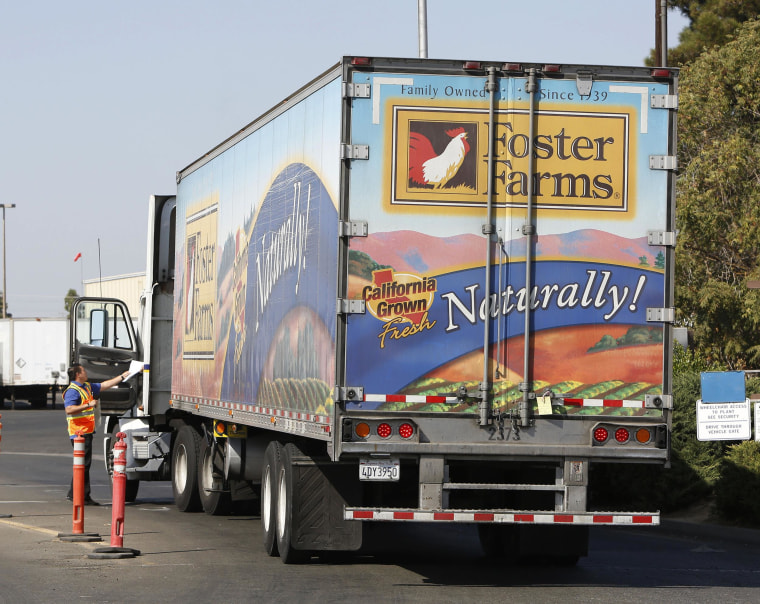Foster Farms poultry producers announced Monday that they’ve dramatically lowered levels of salmonella in chicken parts — and invested $75 million to do it — even as the firm battles a food poisoning outbreak that has sickened nearly 600 people in more than a year.
Most recent 10-week data shared with the U.S. Department of Agriculture showed that salmonella levels in the firm’s chicken parts had dropped to 2 percent — far below the industry benchmark of 25 percent, Foster Farms officials said.

“We’ve achieved these results by taking a multi-hurdle approach that attacks salmonella wherever it can present itself — at the breeder level, on the farm and in the plant,” Dr. Robert O’Connor, the firm's senior vice president of technical services, said. “We are actively sharing what we have learned with government officials, the industry and retailers in the interest of helping to create a safer food supply across the nation.”
The announcement came at a Modesto, California, gathering aimed at marking the family-owned firm’s 75th anniversary. Foster Farms was lauded by Sen. Dianne Feinstein, D-Calif., and Dr. David Acheson, former chief medical officer of the USDA’s Food Safety and Inspection Service and former associate commissioner for foods at the Food and Drug Administration.
"Certainly there was a problem," said Acheson, who is now serving as a paid member of the Foster Farms Food Safety Advisory Board. "They are definitely addressing the problem going forward."
“We’ve achieved these results by taking a multi-hurdle approach that attacks salmonella wherever it can present itself — at the breeder level, on the farm and in the plant."
The safety efforts, however, have not stopped what officials at the Centers for Disease Control and Prevention say is an ongoing outbreak of salmonella poisoning that has sickened at least 574 people since March 2013. Experts with the CDC say the outbreak includes seven strains of drug-resistant salmonella Heidelberg reported in 27 states and Puerto Rico. The cases continue to occur in freshly purchased poultry.
Nearly 40 percent of those sickened have been hospitalized and 13 percent have developed blood infections as a result of their illnesses, a rate nearly three times the typical rate of such serious side effects.
The outbreak follows another outbreak of salmonella Heidelberg tied to Foster Farms chicken that sickened 134 people in 13 states from January to July 2013.
Such cases are regrettable, said Ira Brill, a spokesman for Foster Farms. But he suggested that the cases are a tiny fraction of the 160 million people who eat chicken every day and that the active outbreak should wane very soon.
“The number of illnesses should decline,” Brill said.
It is not possible to eradicate salmonella from raw poultry products, Acheson said, adding that Foster Farms is committed to reducing levels to historic lows.
The effort includes testing incoming birds and refusing flocks that test positive for salmonella as well as intensive reviews of plant processes and equipment, officials said.
Foster Farms and food safety officials advise consumers to handle raw poultry safely, keeping it refrigerated and separated from other foods. The meat should be cooked to 165 degrees Fahrenheit and all cooking surfaces, utensils and other contacts should be thoroughly washed with hot water and soap to avoid cross-contamination.